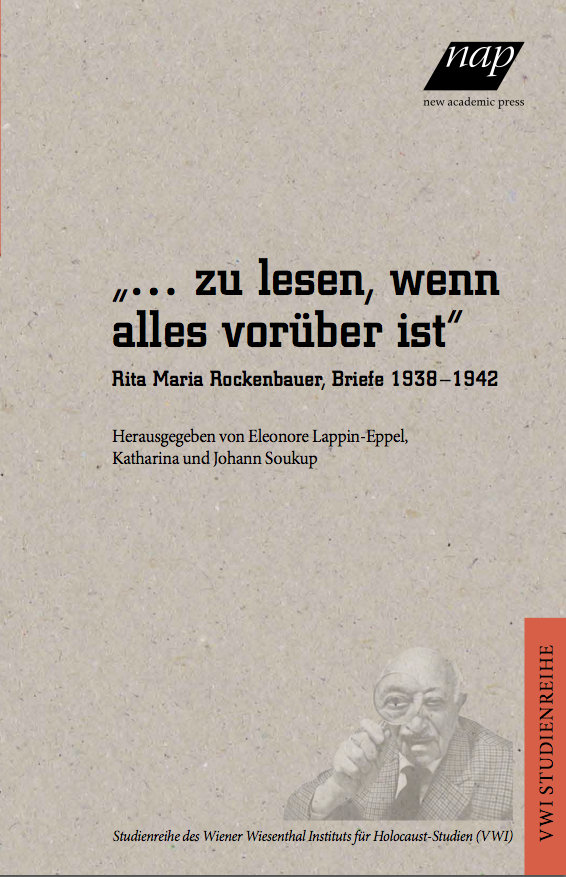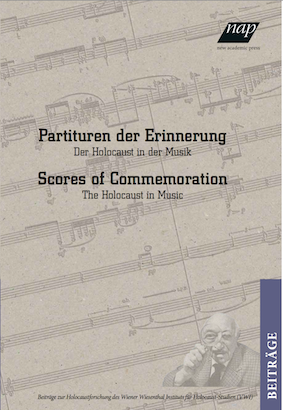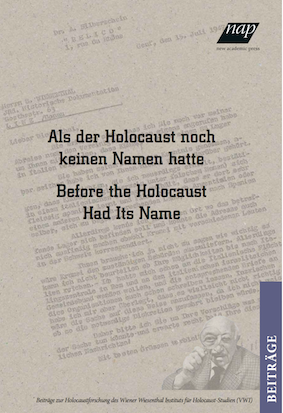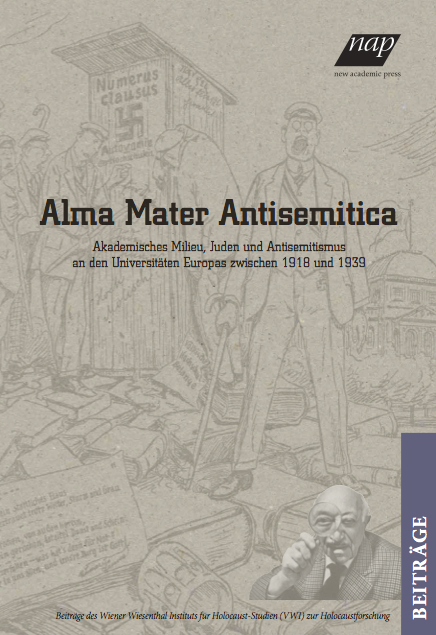 This paper outlines a historical and critical survey of the contribution of psychoanalysis and other ‘psycho-sciences’ to our contemporary understanding of Holocaust trauma. It argues that the theme of mass traumatisation effects originates in the use of psychiatric knowledge and procedures during the First World War. As part of the war machine, psychiatry had special functions in the mobilisation of the masses as well as in the treatment and rehabilitation of those soldiers who suffered from ‘shell shock’ and later developed ‘traumatic neurosis’ or ‘war neurosis’. The main task of psychiatrists at that time was to cure these soldiers as quickly and effectively as possible – in order to send them back to the same dangerous circumstances, which had caused their symptoms in the first place. In treating war neurotics, brutal punitive methods such as painful electric shocks were frequently used. Based on archival sources, and on the correspondence between Sigmund Freud and Sándor Ferenczi, the application of these methods is illustrated here through the example of a Hungarian military doctor, Viktor Gonda. The majority of army doctors regarded war neurosis as a character deficiency, a sign of a ‘feminine’ character. It was thought that this kind of ‘male hysteria’ could also affect ‘healthy’ soldiers, destroying their will, determination, patriotism, and heroism. By contrast, the psychoanalytic conception of war neurosis developed by Sándor Ferenczi in Hungary and by Karl Abraham and Ernst Simmel in Germany was intended to be a humanising alternative to the dominant, mainly ‘punishing’ and torturous procedures applied by mainstream military psychiatry. Psychoanalysts emphasised the importance of understanding the patient’s symptoms, assuming that their explanation originated in the patient’s life history and unconscious motives rather than exclusively in external, physical causes. The psychoanalytic approach to war neurosis anticipated later debates on the nature of individual and collective psychological traumata. This paper surveys the impact of the First World War on the development of the theory and technique of psychoanalysis, including the concepts of Freud, Ferenczi, Melanie Klein, Abram Kardiner, and others. After the Second World War, psychoanalysis was preoccupied with the exploration of the ‘Nazi mind’, the specific psychological and characterological traits of war criminals, their supporters, and their collaborators. This paper argues that the existence of a Holocaust trauma as a separate group of symptoms was for a long time not really acknowledged. e focus only shi ed from perpetrators to victims in the 1970s, due to the introduction of the diagnostic category of PTSD (post-traumatic stress disorder) into the vocabulary of psychoanalysis. This paper, however, argues that the concept of PTSD preserved, in some ways, the dominant discourse of First World War psychiatry, continuing, in a subtler way, to stigmatise or blame the victims.
This paper outlines a historical and critical survey of the contribution of psychoanalysis and other ‘psycho-sciences’ to our contemporary understanding of Holocaust trauma. It argues that the theme of mass traumatisation effects originates in the use of psychiatric knowledge and procedures during the First World War. As part of the war machine, psychiatry had special functions in the mobilisation of the masses as well as in the treatment and rehabilitation of those soldiers who suffered from ‘shell shock’ and later developed ‘traumatic neurosis’ or ‘war neurosis’. The main task of psychiatrists at that time was to cure these soldiers as quickly and effectively as possible – in order to send them back to the same dangerous circumstances, which had caused their symptoms in the first place. In treating war neurotics, brutal punitive methods such as painful electric shocks were frequently used. Based on archival sources, and on the correspondence between Sigmund Freud and Sándor Ferenczi, the application of these methods is illustrated here through the example of a Hungarian military doctor, Viktor Gonda. The majority of army doctors regarded war neurosis as a character deficiency, a sign of a ‘feminine’ character. It was thought that this kind of ‘male hysteria’ could also affect ‘healthy’ soldiers, destroying their will, determination, patriotism, and heroism. By contrast, the psychoanalytic conception of war neurosis developed by Sándor Ferenczi in Hungary and by Karl Abraham and Ernst Simmel in Germany was intended to be a humanising alternative to the dominant, mainly ‘punishing’ and torturous procedures applied by mainstream military psychiatry. Psychoanalysts emphasised the importance of understanding the patient’s symptoms, assuming that their explanation originated in the patient’s life history and unconscious motives rather than exclusively in external, physical causes. The psychoanalytic approach to war neurosis anticipated later debates on the nature of individual and collective psychological traumata. This paper surveys the impact of the First World War on the development of the theory and technique of psychoanalysis, including the concepts of Freud, Ferenczi, Melanie Klein, Abram Kardiner, and others. After the Second World War, psychoanalysis was preoccupied with the exploration of the ‘Nazi mind’, the specific psychological and characterological traits of war criminals, their supporters, and their collaborators. This paper argues that the existence of a Holocaust trauma as a separate group of symptoms was for a long time not really acknowledged. e focus only shi ed from perpetrators to victims in the 1970s, due to the introduction of the diagnostic category of PTSD (post-traumatic stress disorder) into the vocabulary of psychoanalysis. This paper, however, argues that the concept of PTSD preserved, in some ways, the dominant discourse of First World War psychiatry, continuing, in a subtler way, to stigmatise or blame the victims.
Editorial
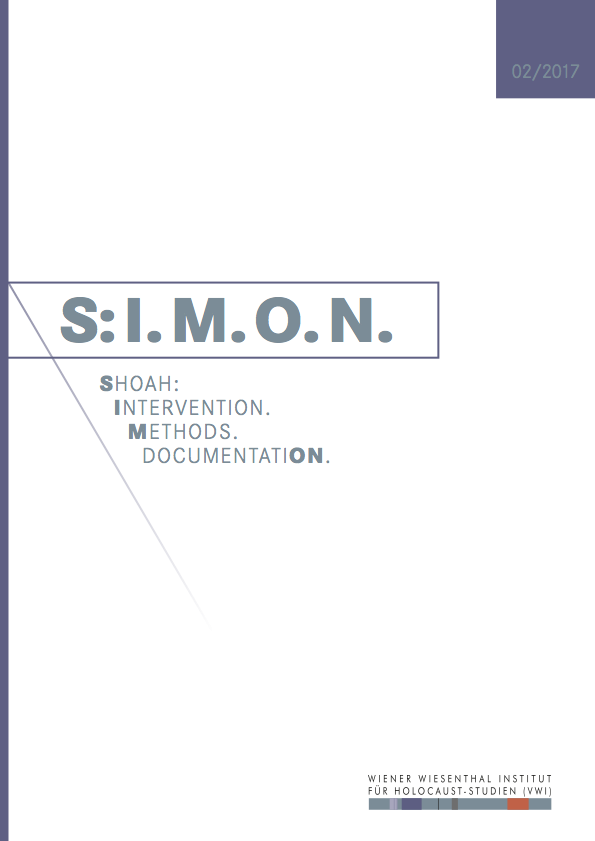 S:I.M.O.N. is an e-journal of the Vienna Wiesenthal Institute for Holocaust Studies (VWI). It appears twice a year in English and German language. S:I.M.O.N. aims at both a transnational and comparative history of the Holocaust and Jewish Studies in Central and Eastern Europe within the broader contexts of the European history of the 20th and 21st century, including its prehistory, consequences and legacies as well as the history of memory.
S:I.M.O.N. is an e-journal of the Vienna Wiesenthal Institute for Holocaust Studies (VWI). It appears twice a year in English and German language. S:I.M.O.N. aims at both a transnational and comparative history of the Holocaust and Jewish Studies in Central and Eastern Europe within the broader contexts of the European history of the 20th and 21st century, including its prehistory, consequences and legacies as well as the history of memory.
S:I.M.O.N. serves as a forum for discussion of various methodological approaches. The journal especially wishes to strengthen the exchange between researchers from different scientific communities and to integrate both the Jewish history and the history of the Holocaust into the different “national” narratives. It also lays a special emphasis on memory studies and the analysis of politics of memory. S:I.M.O.N. uses a double-blind review system, which means that both the reviewer’s and the author’s identities are concealed from each other hroughout the review process.
Shoah: The journal deals with the history of the Shoah from multidisciplinary, transnational and comparative perspectives. It seeks to integrate studies on Jews as well as on other groups of victims of the Holocaust, especially on Roma, and of so far less researched regions of (East) Central and (South) Eastern Europe.
Intervention. The journal reports on research projects and their transmission into public events. It also informs about current educational and remembrance programs.
Methods. The journal serves as a forum for the discussion of methodological approaches as, for instance, the everyday history, oral history, gender history, the history of violence, anti-Semitism and racism and the theory of memory and memory politics.
DocumentatiON. The journal contributes to critical approaches on using and interpreting archival materials in the 21st century.
Download the current issue S:I.M.O.N. 2017/2.
Articles
Christina Winkler
Der russische Blick auf die Shoah
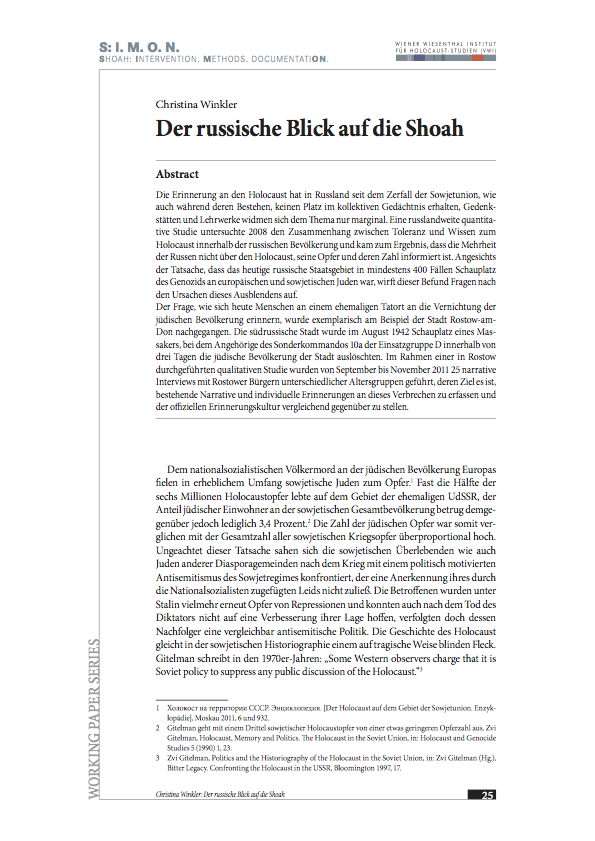 Both during the Soviet era and after its collapse, there has been no room for Holocaust remembrance in Russia's collective memory; memorials and textbooks only marginally touch on the topic. In 2008, quantitative research across Russia investigated the relationship between tolerance and Holocaust knowledge within the Russian population and concluded that the majority of Russians were not aware of the Holocaust, its victims and their numbers. Considering the fact that the current territory of Russia includes at least 400 sites of perpetration of the genocide of European and Soviet Jews, these results urge the question of the causes for this suppression.
Both during the Soviet era and after its collapse, there has been no room for Holocaust remembrance in Russia's collective memory; memorials and textbooks only marginally touch on the topic. In 2008, quantitative research across Russia investigated the relationship between tolerance and Holocaust knowledge within the Russian population and concluded that the majority of Russians were not aware of the Holocaust, its victims and their numbers. Considering the fact that the current territory of Russia includes at least 400 sites of perpetration of the genocide of European and Soviet Jews, these results urge the question of the causes for this suppression.
The city of Rostov-on-Don served as an example in order to address the question of how people now remember the former site of the extermination of the Jewish population. This southern Russian city became the site of a massacre in August 1942, when members of the special commando 10a, part of Einsatzgruppe D annihilated the Jewish population of the city within three days. In the context of qualitative research undertaken in Rostov, 25 narrative interviews were conducted with citizens of Rostov from a range of age groups between September and November 2011. It was the aim of the interviews to record the existing narrative and individual memories of this crime and to compare and contrast these with the official culture of remembrance.
SWL-Reader
 The network of camps that eventually covered almost all of Europe under the management of the SS was a firm component of the national socialist system of terror and defined the Nazi regime in its essence. From the British channel island Alderney to the Soviet Union and from the Baltic to Greece, there was hardly a place in the Nazi sphere of power without one form or another of such a camp. The names of the large concentration and extermination camps have today become synonyms for Nazi state terror, and are perfect metaphors of terror, dehumanisation and racist mass murder. Paradoxically, however, this development at the same time saw the erasure of the traces of those countless small camps in the system: the network that made the terror possible in the first place down to its last branch. They have been lost from Europe's cultural memory.
The network of camps that eventually covered almost all of Europe under the management of the SS was a firm component of the national socialist system of terror and defined the Nazi regime in its essence. From the British channel island Alderney to the Soviet Union and from the Baltic to Greece, there was hardly a place in the Nazi sphere of power without one form or another of such a camp. The names of the large concentration and extermination camps have today become synonyms for Nazi state terror, and are perfect metaphors of terror, dehumanisation and racist mass murder. Paradoxically, however, this development at the same time saw the erasure of the traces of those countless small camps in the system: the network that made the terror possible in the first place down to its last branch. They have been lost from Europe's cultural memory.
Wolfgang Benz provides a systematic presentation of this knowledge, making it accessible again on the basis of the nine volume standard oeuvre on the history of Nazi concentration camps which he published together with Barbara Distel.
Events
Zoltán Halasi
Duschehubka
 This text is the penultimate chapter of Zoltán Halasi's book Út az üres éghez (Road to an Empty Sky). With this work, which was first published in Hungarian, the author created a singular memorial to Polish-Jewish culture and its destruction. Setting out from the Yiddish Holocaust poem Dos lid funm ojsgehargetn jidischen folk by Itzhak Katzenelson, Halasi records what was lost in the Shoah in the course of nineteen compelling chapters. He takes on the grab of an art historian, a literary critic and a travel guide when he reports about a wooden synagogue and the Jewish quarter in Warsaw. In the role of a German banker, he illuminates the aims of the Nazi monetary policies, as a writer of SS brochures he highlights the absurdity of racism. Depicting a Selektion in the Warsaw ghetto, he shows the grim logic of compulsive acts in catastrophic situations, draws an image of the running of the extermination camp Treblinka. The cynical words of two German policemen provide an insight into the rituals of mass executions and introduce us to the craft of murder. The final chapter is an interplay of slithers of narrative by Jewish children on the run and by those who helped and hid them that borders on the unbearable.
This text is the penultimate chapter of Zoltán Halasi's book Út az üres éghez (Road to an Empty Sky). With this work, which was first published in Hungarian, the author created a singular memorial to Polish-Jewish culture and its destruction. Setting out from the Yiddish Holocaust poem Dos lid funm ojsgehargetn jidischen folk by Itzhak Katzenelson, Halasi records what was lost in the Shoah in the course of nineteen compelling chapters. He takes on the grab of an art historian, a literary critic and a travel guide when he reports about a wooden synagogue and the Jewish quarter in Warsaw. In the role of a German banker, he illuminates the aims of the Nazi monetary policies, as a writer of SS brochures he highlights the absurdity of racism. Depicting a Selektion in the Warsaw ghetto, he shows the grim logic of compulsive acts in catastrophic situations, draws an image of the running of the extermination camp Treblinka. The cynical words of two German policemen provide an insight into the rituals of mass executions and introduce us to the craft of murder. The final chapter is an interplay of slithers of narrative by Jewish children on the run and by those who helped and hid them that borders on the unbearable.
The chapter reproduced on the following pages has three parts: Part one is a Treblinka railway station master's report to the Polish Home Army. In the second part, a former Jewish detainee who managed to escape from the extermination camp Treblinka gives a literary treatment of his arrival at the camp. The final part consists of an inner monologue by the Treblinka extermination camp's director of administration.
The book will shortly be published in Polish at the Nisza publishing company in Warsaw. The German-speaking public was first presented with the work on December 1, 2015 at the Simon Wiesenthal Conference 2015. The German translation by Éva Zádor and Heinrich Eisterer is in progress.
Ferenc Erős: From War Neurosis to Holocaust Trauma. An Intellectual and Cultural History
„... zu lesen, wenn alles vorüber ist“
Rita Maria Rockenbauer, Briefe 1938 –1942
Wien 2014
Partituren der Erinnerung.
Der Holocaust in der Musik
Scores of Commemoration.
The Holocaust in Music
Wien 2015
Before the Holocaust Had Its Name. Early Confrontations of the Nazi Mass Murder of the Jews
Wien 2016
Akademisches Milieu, Juden und Antisemitismus an den Universitäten Europas zwischen 1918 und 1939
Academic Milieu, Jews and Antisemitism at European Universities between 1918 and 1939
Wien 2016



